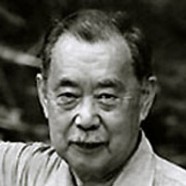 Interviewee: George Nakashima
Interviewee: George Nakashima
Date of birth/age at interview: May 42, 1905/79
Interviewer: Rita Durrant
Interview date: September 11, 1984
Interview location: Nakashima Studio
Interview length: 1 hour, 30 minutes
Time span discussed: 1920s to 1984
Summary: A long interview with discussions outside the normal New Hope art scene. George’s remembrances of complex early life events from Spokane, Japan, and India and his MIT education leading up to internment during World War II bring clarity to the times that lead him finally to Solebury. Thoughts on the “reasons why” for those events are proffered. Along with patience and a reflective mind, George has a gentle laugh. His views are deeply felt, but couched in sincerity and forward thinking.
Time markers:
00:01:47 – Olympic Mountain range; the valley with large trees
00:03:02 – mother Suzu in the Japanese emperor’s court
00:04:16 – Tokyo to visit grandparents; family roots from the Samurai class; (interviewer speaks)
00:06:08 – discipline of his craft
00:08:42 – “I am more appreciated in Japan”; shy of publicity
00:09:51 – his time in Japan working with/for Antonin Raymond
00:11:10 – working in India, fond of India and the people
00:12:58 – spirituality and the Indian mind
00:13:34 – difficulties of travel during World War II
00:15:10 – met Seattle-born wife in Tokyo, marries in 1941
00:17:12 – interned in Utah April 1942 with 6-week-old daughter Mira; musings about reasons and people behind internment
00:22:10 – worked with (apprenticed to) a carpenter in the camp
00:23:06 – doctors in camp, births and deaths; harsh areas
00:24:54 – sense of humor helped him through
00:26:54 – Antonin Raymond invites George and his family to Solebury in 1943
00:27:50 – farming for Raymond; George concluded he was “not cut out to be a farmer”
00:28:15 – community very helpful as he started a business; local restaurants bought tables; design work for Widdicomb Furniture Company
00:31:52 – did not want to live in New Hope, too crowded; brief time at House and Home magazine
00:33:00 – bought property on Aquetong Road where house and business remain
00:34:40 – built shop first
00:36:00 – bought Bill Ney’s non-working car with 4 good tires, got it running; Andy MacDowell helped
00:37:34 – built the house himself; neighbors loaned him money; others helped, built other facilities barn-raising style; continued design work with Widdicomb
00:42:09 – son Kevin born 1955; family helped build house
00:43:22 – neighbor puts tent on property; George’s family uses it as house is built
00:49:01 – his workers, some trained at New Hope-Solebury High School
00:51:00 – a place for quality workmanship; first person to call himself a “woodworker”
00:52:30 – MIT education before trip to Japan
00:53:10 – Frank Lloyd Wright’s work, his egotism distasteful
00:56:20 – interviewer talks
00:57:15 – Bauhaus philosophy and influence; Louis Sullivan
00:58:48 – works at Smithsonian, Victoria and Albert, others
01:00:01 – churches he designed
01:00:49 – Maryknoll priests and stories
01:04:12 – designed interior St. Martin
01:04:22 – designed monasteries
01:07:01 – Japanese Emperor honored his work
01:09:58 – great walnut tree, and plans for the wood, dream of building a peace altar, support for the vision, development of the plan (We now know his vision was realized.)
01:25:14 – Russian friends in music world; others to help with his vision
01:27:41 – views of President Reagan and war
